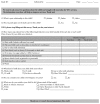Beverage Intake and Its Effect on Body Weight Status among WIC Preschool-Age Children
- PMID: 30800480
- PMCID: PMC6360070
- DOI: 10.1155/2019/3032457
Beverage Intake and Its Effect on Body Weight Status among WIC Preschool-Age Children
Abstract
Given the prevalence and consequences of childhood obesity, efforts are being made to identify risk factors and design evidence-based interventions to reduce its impact. Food and beverage consumption habits are established early in life, making preschool-age children an important group to focus on. This cross-sectional study explored beverage intake and its association with body weight status among low-income preschool-age children enrolled in the Special Supplementation Nutrition Program for Women, Infants, and Children (WIC). Authorized representatives for children between the ages of 3 and 4.9 years were interviewed at WIC clinics in Broward County, Florida. Anthropometric data were collected from the WIC data system. The intake of sugar-sweetened beverages (SSB), particularly fruit drinks, was significantly higher in overweight/obese children when compared with their under/normal weight counterparts. Independent of body weight status, the preschool-age children were consuming on average over twice as much as the recommended intake of 100% fruit juice per day for that age group. Close to 80% of the overweight/obese children consumed low-fat or fat-free milk most often than any other type of milk. The intake of SSB was positively correlated with both the intakes of 100% fruit juice and milk, and negatively correlated with the intake of water. When body weight status, race/ethnicity, and intake of other beverages were held constant, SSB intake was positively associated with milk intake and negatively associated with water intake. Results from this study support the need to encourage water intake and discourage SSB intake in an effort to reduce the risk for overweight and obesity in WIC-participating preschool-age children. Emphasizing the need to follow the recommendation to limit 100% fruit juice intake to 4 to 6 oz. per day is important when counseling families with young children. Efforts to increase awareness of the health consequences associated with consuming high-fat milk should continue.
Figures
Similar articles
-
Beverage intake among preschool children and its effect on weight status.Pediatrics. 2006 Oct;118(4):e1010-8. doi: 10.1542/peds.2005-2348. Pediatrics. 2006. PMID: 17015497
-
Beverage consumption is not associated with changes in weight and body mass index among low-income preschool children in North Dakota.J Am Diet Assoc. 2004 Jul;104(7):1086-94. doi: 10.1016/j.jada.2004.04.020. J Am Diet Assoc. 2004. PMID: 15215766
-
National trends in beverage consumption in children from birth to 5 years: analysis of NHANES across three decades.Nutr J. 2012 Oct 31;11:92. doi: 10.1186/1475-2891-11-92. Nutr J. 2012. PMID: 23113956 Free PMC article.
-
Indian Academy of Pediatrics Guidelines on the Fast and Junk Foods, Sugar Sweetened Beverages, Fruit Juices, and Energy Drinks.Indian Pediatr. 2019 Oct 15;56(10):849-863. Epub 2019 Aug 10. Indian Pediatr. 2019. PMID: 31441436 Review.
-
Satisfying America's Fruit Gap: Summary of an Expert Roundtable on the Role of 100% Fruit Juice.J Food Sci. 2017 Jul;82(7):1523-1534. doi: 10.1111/1750-3841.13754. Epub 2017 Jun 6. J Food Sci. 2017. PMID: 28585690 Review.
Cited by
-
Consumption of Added Sugar among Chinese Toddlers and Its Association with Picky Eating and Daily Screen Time.Nutrients. 2022 Apr 28;14(9):1840. doi: 10.3390/nu14091840. Nutrients. 2022. PMID: 35565808 Free PMC article.
-
The association between sugar-sweetened beverages and milk intake with emotional and behavioral problems in children with autism spectrum disorder.Front Nutr. 2022 Aug 4;9:927212. doi: 10.3389/fnut.2022.927212. eCollection 2022. Front Nutr. 2022. PMID: 35990350 Free PMC article.
-
A Qualitative Study To Understand Parental, Health Care Provider and WIC Nutritionist Perspectives on Early Childhood Beverage Choices for WIC-enrolled Families in a Southeastern US Health System.Matern Child Health J. 2025 May;29(5):628-638. doi: 10.1007/s10995-025-04075-w. Epub 2025 Apr 1. Matern Child Health J. 2025. PMID: 40167858 Free PMC article.
-
Whole milk compared with reduced-fat milk and childhood overweight: a systematic review and meta-analysis.Am J Clin Nutr. 2020 Feb 1;111(2):266-279. doi: 10.1093/ajcn/nqz276. Am J Clin Nutr. 2020. PMID: 31851302 Free PMC article.
-
Contribution of 100% Fruit Juice to Micronutrient Intakes in the United States, United Kingdom and Brazil.Nutrients. 2020 Apr 28;12(5):1258. doi: 10.3390/nu12051258. Nutrients. 2020. PMID: 32354175 Free PMC article.
References
-
- Pan L., Freedman D. S., Sharma A. J., et al. Trends in obesity among participants aged 2-4 years in the special supplemental nutrition program for women, infants, and children - United States, 2000-2014. MMWR. Morbidity and Mortality Weekly Report. 2016;65(45):1256–1260. doi: 10.15585/mmwr.mm6545a2. - DOI - PubMed
-
- Thorn B., Tadler C., Huret N., et al. WIC Participant and Program Characteristics 2014. Alexandria, VA, USA: U.S. Department of Agriculture, Food and Nutrition Service; 2015. https://www.fns.usda.gov/sites/default/files/ops/WICPC2014-Summary.pdf.
-
- Oliveira V., Frazao E. The WIC program: Background, Trends, and Economic Issues. Washington, DC, USA: U.S. Department of Agriculture, Economic Reseacrh Service; 2015.
Publication types
MeSH terms
Substances
Grants and funding
LinkOut - more resources
Full Text Sources
Medical



